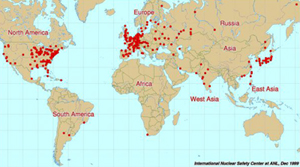| Energy |
|
Worldwide demand for energy increased 16 fold
from 1890 to 1990 and by more than 20% over the decade of the 1990s.
International energy forecasts predict that consumption will further
grow by about 3% per year over the next 20 years. Where does today's
energy come from and where will it come from in the future?
Most of the energy produced today comes from burning
carbon-based "fossil fuels": coal, oil and natural gas, which
are present in finite amounts, essentially nonrenewable and will one
day be exhausted. They are also the usual suspects in being major contributors
to global climate change and global warming. When burned they produce
carbon dioxide, a major greenhouse gas whose atmospheric increase is
coincident with the global rise in temperature.
|
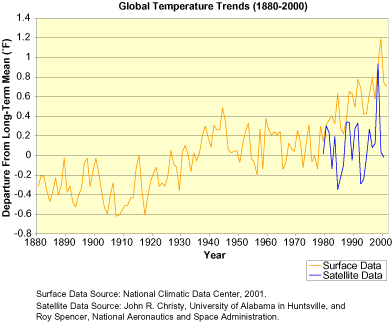 |
| About eighteen pounds of carbon dioxide
is produced for every one gallon of gasoline burned. The average total
amount of carbon emitted per person in the U.S. is over 15,000 lbs per
year and growing at a rate of more than 3% per year!! |
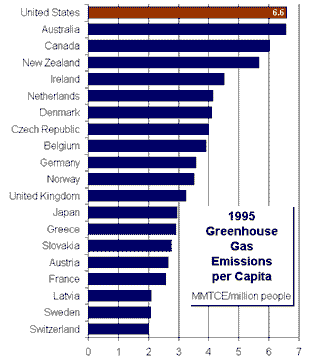 |
| There are alternative sources of energy
that do not produce CO2. However, the amount of energy produced
from all of these sources is currently relatively small compared to that
from fossil fuels. Among some of the alternative sources of energy are
wind, hydroelectric, ethanol (a renewable carbon based fuel), and nuclear
energy. There are complex issues associated with energy production, consumption,
and the environment. Each source has its advantages and disadvantages.
Consider nuclear energy, its history and its future possibilities. |
|
| Nuclear Energy |
 |
The nucleus consists of two fundamental
particles, the proton and the neutron. Einstein theorized that under certain
conditions at or near the speed of light, matter and energy were interconvertible.
His theory was proven during World War II, when a nuclear reaction converted
a very small atomic mass to an awesome amount of energy.
|
|
|
| In August 1945, two "atomic"
bombs, "Fat Man" and "Little Boy", were detonated,
annihilating the Japanese cities of Hiroshima and Nagasaki. [Click on
the image above to hear President Truman's announcement, and read a draft
of the press release:White
House draft.] The terror of the catastrophic potential of nuclear
weapons lead to the Cold War and an escalation in the number and type
of nuclear weapons in the world arsenal. The atomic bombs used in World
War II released energy from a nuclear fission reaction, where a large
nucleus splits to form smaller nuclei and give off an enormous amount
of energy plus neutrons [click on the following image], which cause the
reaction to repeat again and again as a chain
reaction. |
 |
| The first atomic bombs
were followed by weapons designed around a different nuclear reaction.
The new weapons were called "hydrogen" bombs, after their nuclear
fuel. They were much smaller and much more powerful than their predecessors.
The hydrogen bombs were based on nuclear fusion, the nuclear reaction
that occurs on the sun and stars, where small atomic nuclei combine to
form larger atoms and concomitantly produce enormous amounts of energy.
The "hydrogen" bomb is so called because it uses deuterium and
tritium, isotopes of hydrogen [click on the following image]. |

|
The first atomic bombs were followed
by weapons designed around a different nuclear reaction. The new weapons
were called "hydrogen" bombs, after their nuclear fuel. They
were much smaller and much more powerful than their predecessors. The
hydrogen bombs were based on nuclear fusion, the nuclear reaction that
occurs on the sun and stars, where small atomic nuclei combine to form
larger atoms and concomitantly produce enormous amounts of energy. The
"hydrogen" bomb is so called because it uses deuterium and tritium,
isotopes of hydrogen [click on the following image].
|
|
|
The first atomic bombs were followed
by weapons designed around a different nuclear reaction. The new weapons
were called "hydrogen" bombs, after their nuclear fuel. They
were much smaller and much more powerful than their predecessors. The
hydrogen bombs were based on nuclear fusion, the nuclear reaction that
occurs on the sun and stars, where small atomic nuclei combine to form
larger atoms and concomitantly produce enormous amounts of energy. The
"hydrogen" bomb is so called because it uses deuterium and tritium,
isotopes of hydrogen [click on the following image].
|
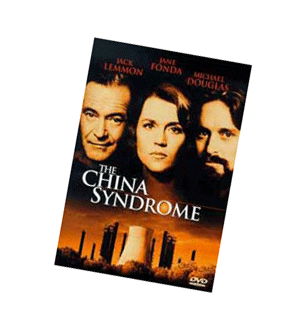 |
| The movie, The China Syndrome,
painted a scenario for an accident at a nuclear power plant
where a runaway nuclear reaction might cause a reactor to
"melt down".... and wind up in China. Following
the movie's release, accidents occurred at nuclear power plants
in 1979 at Three Mile Island in the U.S. and Chernobyl, in
the Ukraine in 1986. The risk of a nuclear accident so alarmed
the public that there has not been a new nuclear plant built
in the U.S. since 1979, and only a few have been completed
worldwide; the most recent in China. |
|
|
An argument has been made that since
nuclear plants do not produce CO2, they are good choices for
future power generation because of their environmental advantages, and
more of them should be built. This goes along with the concomitant claim
that the plants can be safely operated. However, there are environmental
considerations other CO2 that are disadvantages. Waste disposal
of the spent nuclear fuel, which is hazardous and stays so for inordinately
long periods of time, and what to do with the plant's reactor, equipment
and containment buildings once they are no longer operational but are
still highly radioactive, are two important concerns. (The licensing period
in the U.S. for nuclear reactors is 20 years; extendable for another 20
years with approval of the Department of Energy's (DOE) / Nuclear Regulatory
Commission's (NRC) licensing body.) There currently are 43,000 metric
tons of accumulated nuclear waste stored at reactor sites throughout the
U.S., and the amount is growing at 2,000 metric tons per year.
|
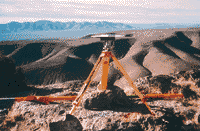 |
| The DOE has undertaken a $60 billion
under-mountain desert project in Yucca Mountain, Nevada, which received
final congressional approval in July 2002. It will be the final repository
for up to 70,000 metric tons of nuclear waste. |
|
|









